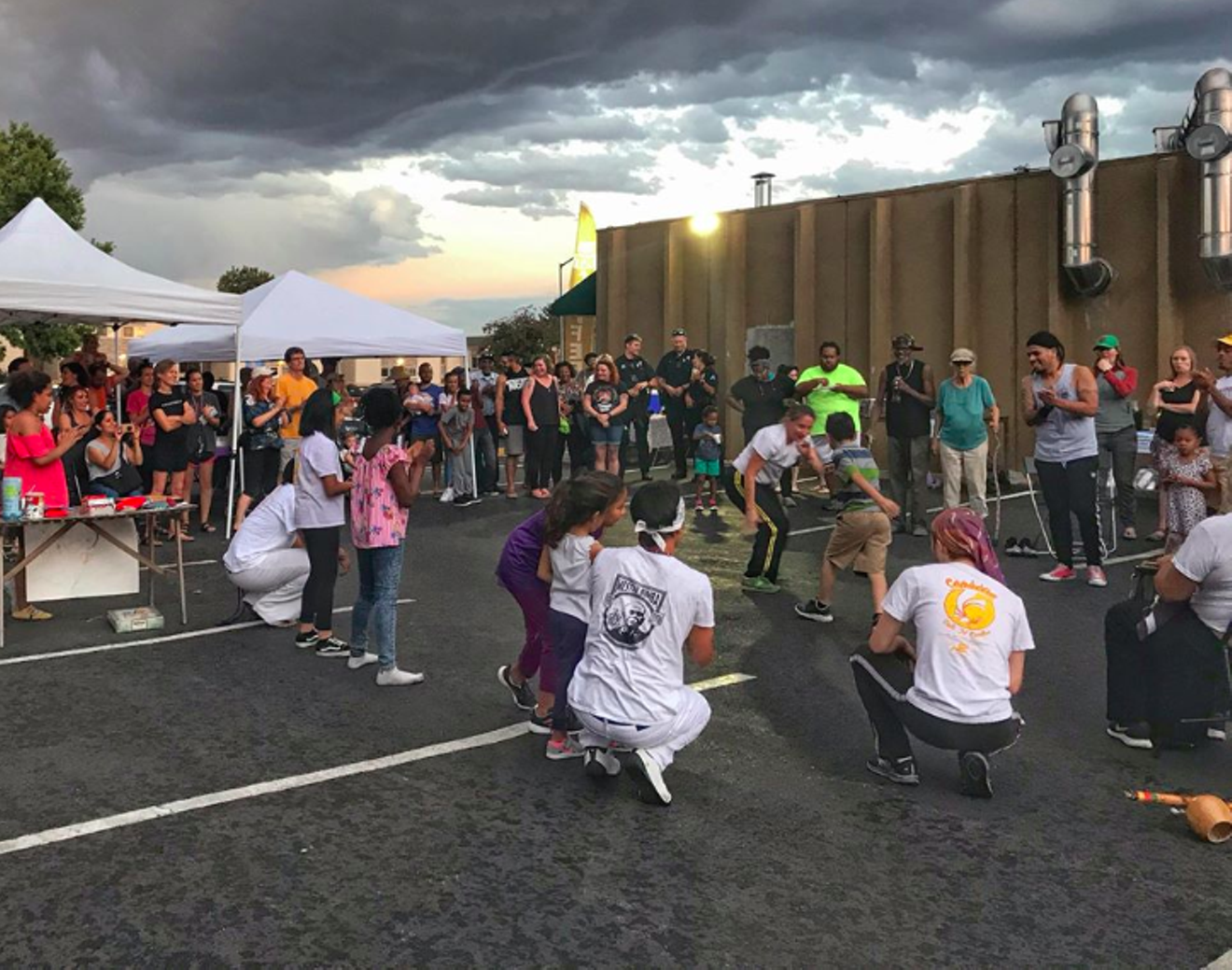Tim Roberts never meant to end up as the president of the East Colfax Neighborhood Association. His path to the position began when his small press and arts space, Counterpath, was priced out of its previous downtown location by a fourfold rent increase in 2015. After searching for a new location, he landed on the much more affordable East Colfax neighborhood.
Before setting up shop, he had to check in with the Registered Neighborhood Organization (RNO). The East Colfax Neighborhood Association, one of the oldest of the 224 officially recognized neighborhood groups in the city, lacked a space of its own and had been meeting outside of the neighborhood itself. Once Counterpath was established at its new location at East 14th Avenue and Tamarac Street, Roberts offered the space to the organization and began attending meetings.
While Roberts, a 2013 Westword MasterMind, was happy to provide a space to the community, he immediately noticed that the conversations skewed toward a certain population of East Colfax. “They didn’t really almost ever target renters’ typical issues — renters’ rights, things of that nature,” he says. “There was almost never a reference to the fact that the level of people who are at risk of displacement in the neighborhood is at 70 percent. And almost never a reference to the fact that upwards of 40 percent were listed as living in poverty [in the section of the neighborhood south of Colfax]. That was just not a topic ever, let alone the RNO mobilizing to actually do something about it and to protect those populations. That was like another universe; somebody else does that stuff.”
Roberts was elected president of the RNO at the beginning of 2019. Under his leadership, the East Colfax Neighborhood Association did away with membership fees and started knocking on the doors of residents who hadn’t historically participated in the group. It put together pay-what-you-can block parties that featured food from immigrant-owned restaurants. It funded a food bank at Counterpath, open for two hours every week. At its October meeting, the organization voted unanimously on a resolution declaring that preventing involuntary displacement was its number-one priority.
While RNOs have long been a powerful fixture of local politics, often viewed (though sometimes ignored) by the city and politicians as the voice of their neighborhoods, they have a reputation for representing only a certain slice of the city. It’s the slice that has the time and resources to make it to hours-long evening meetings and write public comments about zoning proposals and liquor licenses to be presented at city council hearings. A slice that is older, wealthier and whiter than the general population.
“RNOs were founded by property owners in almost 100 percent of cases and have been run by them and taken root and exist to this day as an outgrowth of that particular community,” Roberts says. He wants to see that change citywide, envisioning RNOs not as councils of landowners protecting their interests, but as grassroots organizations that provide a platform for the organization and representation of the neighborhood’s most vulnerable voices.
The result, he hopes, could amplify grassroots politics. The proposal he’s putting forth to change the ordinance governing RNOs, however, could prove plenty controversial.
Roberts and the East Colfax Neighborhood Association seek to accomplish two things with their proposed ordinance change, which is currently in draft form. They want to ensure that the city commits resources to RNOs and that the voting membership of RNOs is representative of the population they claim to speak for.
Neighborhood organizations in Denver started popping up in the early twentieth century. In the 1960s and ’70s, they became much more widespread.
Michael Henry became involved in his neighborhood association, Capitol Hill United Neighbors (CHUN), in the early ’70s. CHUN had been established in 1969, when Capitol Hill residents teamed up to successfully fight the city’s proposal to turn 11th and 12th avenues into one-way major thoroughfares.
In Henry’s memory, “After that victory, Capitol Hill neighbors looked at each other and said, ‘Boy, that was fun, we ought to do that again and get some more organizations together and communicate effectively with city government before they decide to do something.’”
As neighbors all over the city coalesced into groups fighting similar battles, Henry helped create the Denver Inter-Neighborhood Cooperation, which brought multiple neighborhood associations to work together on citywide issues and policies. Denver INC still stands today as a powerful citizen group, representing 100 RNOs across the city.
Denver INC worked with city council members to push through an ordinance that established a system for registering neighborhood organizations and requiring the city to notify them about certain projects going on in their neighborhoods. The ordinance passed in 1979 and has not been modified much since. Giving RNOs official recognition in the eyes of the city had a profound influence on Denver politics, Henry says.
The current ordinance gives RNOs a large degree of control and the city a minimum amount of oversight or responsibility. An RNO is defined as “a voluntary group of individual residents and owners of real property, including businesses, within a certain prescribed area of the city, and/or a coalition of such groups formed for the purpose of collectively addressing issues and interests common to and widely perceived throughout the area.” They must hold open meetings a minimum of once every year, with a minimum attendance of twelve people.
“Historically, the idea behind it was that there was one general-interest neighborhood group per area in the city, and they were the way that you participated in civic life,” says Alex Foster, who manages RNO registration for the city's department of Community Planning and Development. But the ordinance doesn’t prevent groups from splintering off or starting their own groups that overlap with the boundaries of other RNOs. As time went on, neighbors who disagreed on issues started their own organizations, and smaller communities within neighborhoods — such as homeowners' associations at condominium complexes — have registered as RNOs. As a result, Denver has 224 RNOs, even though statistically, it only has 78 neighborhoods.
The city, in turn, is required to notify RNOs about a variety of happenings in their boundary areas, including zoning change proposals, the sale of city-owned land, liquor license applications, landmark designation applications, marijuana retail applications and more. It also maintains a map and directory of all RNOs in the city.
That keeps RNOs involved in city council meetings, planning board hearings, and more public happenings. But, Foster notes, “generally RNOs don’t have any sort of veto power over anything. … They don’t necessarily have a hand on a lever that says, 'Nope, we don’t want this, therefore it’s not going.'”
It’s up to RNOs to decide how to fund themselves, how to attract members (though the ordinance requires that notice of meetings be posted in public places) or what sorts of issues to focus on. “We want RNOs to be inclusive and be as engaged in their communities as possible, but the ordinance is written as the bare minimum. The onus on that engagement is on them,” says Foster. The city currently does not "weigh in on how RNOs run themselves,” she says.
Because the city doesn’t require RNOs to disclose their budget or disaggregated membership data, there are no statistics that indicate how well they represent their particular neighborhoods or which have the most social and financial capital.
However, it’s easy to see that different RNOs vary wildly. Some maintain glossy websites with detailed information about neighborhood happenings, while others barely have an online presence. The East Colfax Neighborhood Association is free to join, and is struggling to fund its next neighborhood block party. Country Club Historic Neighborhood, meanwhile, charges a hefty $250 annual membership fee. Others have extensive grant funding and put on classy end-of-year galas.
Notes Henry, “Some of them are very large, some are very small, some are new, some are a lot more established, some are reasonably well funded and others not at all, some are experienced and others not.”
In early April of this year, Roberts and Amy Razzaque, head of the Overland Park Neighborhood Association, convened a one-day conference called “Into the Neighborhood,” with the goal of examining RNOs from a critical standpoint.
The problem of inadequate representation came up again and again, Roberts says. “If you have a group of people coming together that really, truly is representative of the populations that are there, you’re gonna get a much more authentic voice coming from different geographical regions.”
Roberts argues that the issue is even more urgent as the city unfolds its Neighborhood Planning Initiative, which is supposed to give every neighborhood a vision that guides future development according to community desires. According to Foster, the city doesn't require that RNOs get a seat on the steering committees that lead these plans, but the active and established ones usually do join. In a city council committee hearing on November 12, some councilmembers voiced concerns that the representative of the RNO was being taken as the voice of the entire community when there was no requirement that RNOs reach out to non-members.
That problem has hit hard on East Colfax. The city's East Area Plan, which has been ongoing for the past several years, is extremely controversial. Some residents, including Roberts, are worried that it doesn't establish strong enough protections against displacement. The East Colfax Neighborhood Association has even started developing its own neighborhood plan.
The proposed ordinance change would require RNOs to track their “regular, voting membership” and ensure that it mirrors the socioeconomic diversity of their geographical boundaries. Those that reflect the diversity of their real neighborhood population within a 10 percent margin would get an “A” rating from the city, those within 10 to 15 percent would get a “B” rating, and those in excess of 15 percent would be de-listed and lose their official status.
It’s a fairly strict requirement that Roberts says would de-list even his own RNO. Even with all the work they’ve done to reach out to marginalized populations, the East Colfax Neighborhood Association is still whiter and wealthier than the neighborhood at large, one of Denver’s most diverse and most impoverished. Megan Tortorelli, an RNO boardmember who got involved after Roberts was elected president, says changing that has been a "slow, hard, process."
"For people who are just busier or working multiple jobs or don’t have child care, it’s extremely difficult to be involved in meetings," she says. "The language barrier is a huge challenge."
Additionally, renters may not know that they can participate in their RNO. And while millennials may enjoy posting angry rants on NextDoor, they don't tend to show up at RNO meetings.
Roberts says he’s open to suggestions for how RNOs could be required to be more representative, but he feels that the city should set the bar high. He has sent the draft ordinance change to all RNO leaders in the city.
Travis Leiker, president of CHUN, says his group recognizes there is a problem: "Historically, being engaged in the community sometimes lends itself to those who come from positions of privilege, from meeting times to dates to locations to outreach."
"I think this proposal is an interesting concept and opens the door for us to re-evaluate how and to what extent RNOs are regulated and supported," he adds. But, he says, "there needs to be some sort of parameters established around the funding and part-time staff to make sure the city’s resources are being put to good use." It doesn't make much sense for the city to fund already lucrative organizations, he explains, and it would have to set up standards to ensure that RNOs manage their budgets responsibly.
Leiker thinks RNOs should aspire to be representative of those they serve. But he's skeptical that requiring representation is the best way to do that. One potential problem is that RNOs in wealthy, white neighborhoods may already reflect their neighborhood population fairly accurately by virtue of the people in them. It's the RNOs in economically and socially diverse neighborhoods that would be held to higher standards. "The implementation is going to be a little challenging, and I think this plan needs to be reviewed a little bit more," he continues.
George Mayl, the president of Denver INC, says, "When I got this [proposal], I was blinking my eyes. I don’t see any way that we’re going to change any way the RNOs are." He wants to sit down with Roberts and the East Colfax Neighborhood Association and learn more about their plan. "Right now," he adds, "I see no need to change any ordinance concerning RNOs."
Henry, the founder of Denver INC, shares those concerns. "My sense is that almost every neighborhood group is very concerned about diversity, gentrification and poverty, and we want to find ways to reach out and energize and bring to the discussion young folks, renters and older folks," he says. "Some of us, I think it’s fair to say, are just not too sure that mandated rules from the city or even funding from the city are sensible ways to regulate those very independent and very diverse neighborhoods. I’m just not sure it’s the best way to deal with the very legitimate issues [East Colfax Neighborhood Association] is identifying."
Roberts, on the other hand, is doubtful RNOs will become truly diverse community organizations unless something structural changes. "There’s a whole tradition of not addressing these concerns and to obscure them systematically," he says. "This particular ordinance...has traditionally given voice at the grassroots level only to voices of privilege, and not the other way around. [Changing the ordinance] is not going to solve all problems, but there seems to be something there that can be shifted."
Read the proposal below:
[
{
"name": "Air - MediumRectangle - Inline Content - Mobile Display Size",
"component": "12017618",
"insertPoint": "2",
"requiredCountToDisplay": "2",
"watchElement": ".fdn-content-body",
"astAdList": [
{
"adType": "rectangle",
"displayTargets": "mobile"
}
]
},{
"name": "Editor Picks",
"component": "17242653",
"insertPoint": "4",
"requiredCountToDisplay": "1",
"watchElement": ".fdn-content-body",
"astAdList": [
{
"adType": "rectangle",
"displayTargets": "desktop|tablet"
},{
"adType": "rectangle",
"displayTargets": "desktop|tablet|mobile"
}
]
},{
"name": "Inline Links",
"component": "18838239",
"insertPoint": "8th",
"startingPoint": 8,
"requiredCountToDisplay": "7",
"maxInsertions": 25
},{
"name": "Air - MediumRectangle - Combo - Inline Content",
"component": "17261320",
"insertPoint": "8th",
"startingPoint": 8,
"requiredCountToDisplay": "7",
"maxInsertions": 25,
"watchElement": ".fdn-content-body",
"astAdList": [
{
"adType": "rectangle",
"displayTargets": "desktop|tablet"
},{
"adType": "rectangle",
"displayTargets": "desktop|tablet|mobile"
}
]
},{
"name": "Inline Links",
"component": "18838239",
"insertPoint": "8th",
"startingPoint": 12,
"requiredCountToDisplay": "11",
"maxInsertions": 25
},{
"name": "Air - Leaderboard Tower - Combo - Inline Content",
"component": "17261321",
"insertPoint": "8th",
"startingPoint": 12,
"requiredCountToDisplay": "11",
"maxInsertions": 25,
"watchElement": ".fdn-content-body",
"astAdList": [
{
"adType": "leaderboardInlineContent",
"displayTargets": "desktop|tablet"
},{
"adType": "tower",
"displayTargets": "mobile"
}
]
}
]













